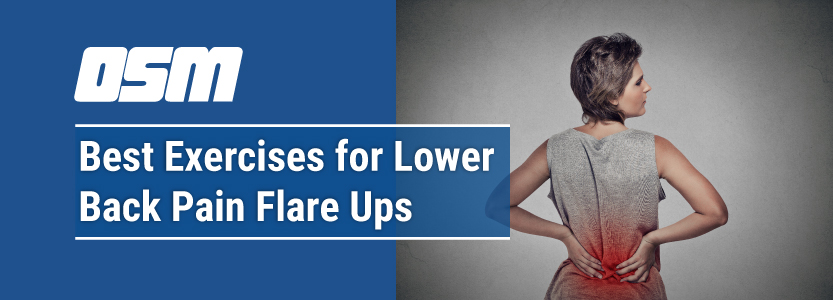Best Exercises for Lower Back Pain Flare-Ups
Article featured on ProTailored
Why Do I Have Low Back Pain?
Low back pain is pain that occurs below the ribs, in the lumbar region of the spine. There are many causes of low back pain. Muscle tightness, injury to the ligaments or discs in the back, or problems with the bones and joints may lead to low back pain. Common causes include improper lifting, poor posture, lack of regular exercise, fracture, ruptured disk, or arthritis. Almost everyone will experience some level of low back pain at some point. Most of the time, your back will start to feel better on its own. However, sometimes the pain will not go away on its own and will require some form of intervention. Physical therapy is a great option to help with low back pain. Our physical therapists can do a full evaluation to determine what may be causing the irritation/inflammation/pain. The treatments will be focused on addressing the cause of the inflammation and helping to decrease pain levels.
Risk Factors for Low Back Pain
Some risk factors of developing low back pain include repetitive movements such as lifting, pulling, or anything that twists the spine. However, sitting at a desk all day can also be hard on your back, especially if your low back is not well supported, or you sit with poor posture.
Prevention of Low Back Pain
Prevention of the low back includes maintaining proper posture while sitting, but also while lifting or pulling. You want to make sure that you bend at the knees and lift with the legs rather than with your back. Exercise and having strong abdominal and back muscles can also help in the prevention of low back pain. If you are prone to low back pain, you may also want to try sleeping on a firm surface, sitting in supportive chairs (that are the correct height), and avoiding high-heeled shoes.
How Can Physical Therapy Help?
Our physical therapists will do a thorough examination to help determine the source of your pain. They will then work towards decreasing the source of the irritation with the use of manual techniques, cupping, scraping, dry needling, and therapeutic exercises. They will also help you determine things to do at home to help you manage and decrease your pain, and work towards preventing future pain.
What Should I Do During Flare-Ups or When I Have a Lot of Pain in the Low Back?
One of the best things that you can do when you have a flare-up or high levels of pain in the low back is to keep the back moving. Your pain levels may be so high that all you want to do is find a comfortable position and not move for a while. However, motion is key in helping alleviate low back pain. But there is a balance here, as you do not want to overdo it and create more pain. Therefore, the best thing to do is work in PAIN-FREE RANGES OF MOTION. That means movements that you can tolerate and that do not increase your pain.
Best Exercises for Flare-Ups of Low Back Pain
Lower Trunk Rotations
- Start by lying on your back with both knees bent
- Slowly rock your knees together to one side; hold for a second or two and then rock to the other side
- If you have sharp pain with this motion, do not go as far!
- This should feel like a stretch and should not be a sharp pain!
- Complete slow rotations back and forth 20x
Single Knee to Chest
- Start by lying on your back with both knees bent
- Bring one knee up to your chest and hold for 5-10 seconds
- Repeat on the other side
- Do this exercise 10x on each side
- If you have sharp pain with this motion, do not go as far!
- This should feel like a stretch and should not be a sharp pain!
Pelvic Tilts
- Start by lying on your back with both knees bent
- Slowly flatten your back into the table
- Then slowly rock your pelvis forward so that only your low back lifts off the table
- Do this exercise back and forth slowly 20x
- If you have sharp pain with this motion, do not go as far!
- This should feel like a stretch and should not be a sharp pain!
Piriformis stretch
- Start by lying on your back with both knees bent
- Bring one leg up and place your ankle on your opposite knee
- Use your hand to put pressure on your knee until you feel a stretch
- Hold this position for 30 seconds and repeat 3x on each side
- If you have sharp pain with this motion, do not go as far!
- This should feel like a stretch and should not be a sharp pain!
The Orthopedic & Sports Medicine Center of Oregon is an award-winning, board-certified orthopedic group located in downtown Portland Oregon. We utilize both surgical and nonsurgical means to treat musculoskeletal trauma, spine diseases, sports injuries, degenerative diseases, infections, tumors and congenital disorders.
Our mission is to return our patients back to pain-free mobility and full strength as quickly and painlessly as possible using both surgical and non-surgical orthopedic procedures.
Our expert physicians provide leading-edge, comprehensive care in the diagnosis and treatment of orthopedic conditions, including total joint replacement and sports medicine. We apply the latest state-of-the-art techniques in order to return our patients to their active lifestyle.
If you’re looking for compassionate, expert orthopedic surgeons in Portland Oregon, contact OSM today.
Phone:
503-224-8399
Address
17355 Lower Boones Ferry Rd Suite 100A
Lake Oswego, OR 97035
Hours
Monday–Friday
8:00am – 4:30pm



